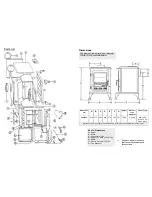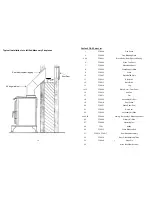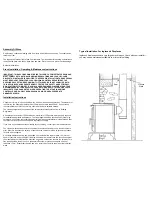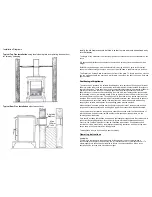
Installation Diagrams
Typical Top Flue Installation
using steel closure plate incorporating clean out door
for chimney sweeping
12
Seal with
fireproof
Max
150mm
Infill
Typical Rear Flue Installation
with clean out door
5
Ideally, the old fireplace should be filled in so that there is a smooth streamlined entry
into the flueway.
The length of any horizontal run of the flue pipe must not exceed the flue outlet diameter on the
stove.
It is essential that all connections between the stove and chimney-flue are sealed and made
airtight.
Both chimney and flue pipe must be accessible for cleaning and if ALL parts of the chimney
cannot be reached through the stove, a soot door must be fitted to enable this this to be done.
The Primary Air Sealing Plate is located on the front of the grate. To locate in position, slacken
the two screws beneath the grate and pull forward, then close the door fully, open door and
tighten screws.
Positioning of Appliance
The stove can be recessed in a suitable sized fireplace but a permanent free air gap of at least
100mm must be left around the sides and top to obtain maximum heat output and for access to
the rear of the stove. There should not be any combustible material within a distance of 600mm
from any surface of the stove. Furniture and general soft furnishings should not be within
900mm of any of the stove surfaces including the stove pipe. In all instances the stove should
be positioned on a non-combustible hearth. Allow an apron of at least 300mm at the front of the
stove and 150mm on either side. The hearth on which the stove is to be placed should not be
less than 125mm thick if the floor is made of combustible material, and care should be taken to
level the stove and secure the hearth. If existing floors do not have adequate load bearing
capacity then suitable modifications to load bearing plates must be adopted.
When the stove is desired position mark hearth through holes in feet, remove stove drill and
plug hearth for securing stove and levelling. See typical flue connection methods illustrated.
Upon completion of installation, the appliance should be checked under fire for soundness of
joints and seals, and also that all smoke and fumes are taken from the appliance, up the
chimney and emitted safely.
Care should be taken that all flues, hearths, and combustion air supplies are in accordance with
the current Building Regulations, Local Authority By-laws, British Standards and Codes of
Practice—the Firefox 5 Clean Burn II has no ventilation requirement. Considerations and
provisions must be made for any other appliances requiring ventilation. An extractor fan must
not be used in the same location as the appliance.
This appliance is not to be used with a shared chimney.
Operating Instructions
Primary Air
Primary air is controlled via the sliding vents in the bottom of the door; this provides a
conventional air draught to the bed of the fire. (+) indicates more air, (-) indicates less air. To
adjust, slightly turn the knob anti-clockwise to loosen, then move sideways. When in the
desired position, turn the knob clockwise until tight.








